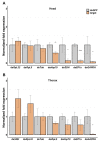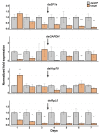Development of RNAi Methods for the Mormon Cricket, Anabrus simplex (Orthoptera: Tettigoniidae)
- PMID: 36005364
- PMCID: PMC9409436
- DOI: 10.3390/insects13080739
Development of RNAi Methods for the Mormon Cricket, Anabrus simplex (Orthoptera: Tettigoniidae)
Abstract
Mormon crickets are a major rangeland pest in the western United States and are currently managed by targeted applications of non-specific chemical insecticides, which can potentially have negative effects on the environment. In this study, we took the first steps toward developing RNAi methods for Mormon crickets as a potential alternative to traditional broad-spectrum insecticides. To design an effective RNAi-based insecticide, we first generated a de novo transcriptome for the Mormon cricket and developed dsRNAs that could silence the expression of seven housekeeping genes. We then characterized the RNAi efficiencies and time-course of knockdown using these dsRNAs, and assessed their ability to induce mortality. We have demonstrated that it is possible to elicit RNAi responses in the Mormon cricket by injection, but knockdown efficiencies and the time course of RNAi response varied according to target genes and tissue types. We also show that one of the reasons for the poor knockdown efficiencies could be the presence of dsRNA-degrading enzymes in the hemolymph. RNAi silencing is possible in Mormon cricket, but more work needs to be done before it can be effectively used as a population management method.
Keywords: Mormon cricket; Orthoptera; RNAi; dsRNA.
Conflict of interest statement
The authors declare no conflict of interest.
Figures




Similar articles
-
Differential responses to double-stranded RNA injection and feeding in Mormon cricket (Orthoptera: Tettigoniidae).J Insect Sci. 2023 Jul 1;23(4):10. doi: 10.1093/jisesa/iead063. J Insect Sci. 2023. PMID: 37527468 Free PMC article.
-
Effects of parental diet on Mormon cricket egg diapause, embryonic development rate, and periodic outbreaks.J Insect Physiol. 2024 Sep;157:104681. doi: 10.1016/j.jinsphys.2024.104681. Epub 2024 Jul 28. J Insect Physiol. 2024. PMID: 39079656
-
Age- and density-dependent prophylaxis in the migratory, cannibalistic Mormon cricket Anabrus simplex (Orthoptera: Tettigoniidae).Environ Entomol. 2012 Feb;41(1):166-71. doi: 10.1603/EN11020. Environ Entomol. 2012. PMID: 22525072
-
Feasibility, limitation and possible solutions of RNAi-based technology for insect pest control.Insect Sci. 2013 Feb;20(1):15-30. doi: 10.1111/j.1744-7917.2012.01513.x. Epub 2012 Jun 12. Insect Sci. 2013. PMID: 23955822 Review.
-
Next Generation dsRNA-Based Insect Control: Success So Far and Challenges.Front Plant Sci. 2021 Oct 18;12:673576. doi: 10.3389/fpls.2021.673576. eCollection 2021. Front Plant Sci. 2021. PMID: 34733295 Free PMC article. Review.
Cited by
-
Differential responses to double-stranded RNA injection and feeding in Mormon cricket (Orthoptera: Tettigoniidae).J Insect Sci. 2023 Jul 1;23(4):10. doi: 10.1093/jisesa/iead063. J Insect Sci. 2023. PMID: 37527468 Free PMC article.
-
The Expression and Function of Notch Involved in Ovarian Development and Fecundity in Basilepta melanopus.Insects. 2024 Apr 19;15(4):292. doi: 10.3390/insects15040292. Insects. 2024. PMID: 38667422 Free PMC article.
-
Effect of marker-free transgenic Chlamydomonas on the control of Aedes mosquito population and on plankton.Parasit Vectors. 2023 Jan 18;16(1):18. doi: 10.1186/s13071-022-05647-3. Parasit Vectors. 2023. PMID: 36653886 Free PMC article.
-
Recent advances in understanding of the mechanisms of RNA interference in insects.Insect Mol Biol. 2025 Aug;34(4):491-504. doi: 10.1111/imb.12941. Epub 2024 Jul 3. Insect Mol Biol. 2025. PMID: 38957135 Free PMC article. Review.
References
-
- Cowan F.T. Life History, Habits and Control of the Mormon Cricket. Volume 161. United States Department of Agriculture Technical Bulletin; Washington, DC, USA: 1929. pp. 1–28.
-
- Cowan F.T., Wakeland C.C. Mormon Crickets: How to Control Them. US Department of Agriculture; Washington, DC, USA: 1962.
-
- Wakeland C.C. Mormon Crickets in North America. US Department of Agriculture; Washington, DC, USA: 1959.
-
- Gwynne D.T. Katydids and Bush-Crickets: Reproductive Behavior and Evolution of the Tettigoniidae. Cornell University Press; Ithaca, NY, USA: 2001.
Grants and funding
LinkOut - more resources
Full Text Sources

